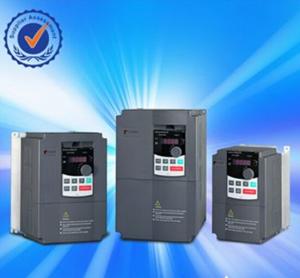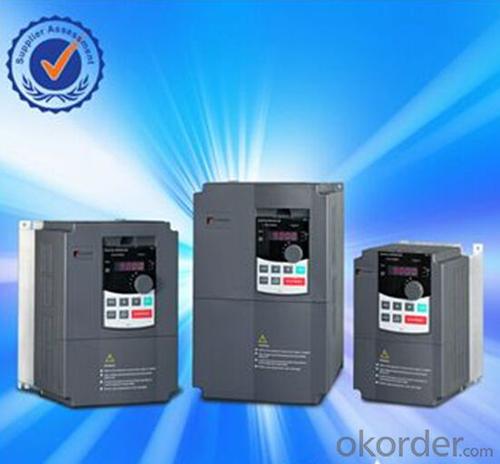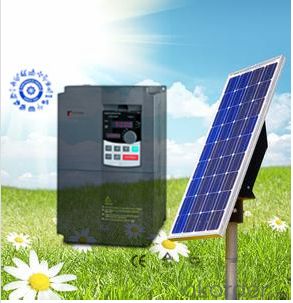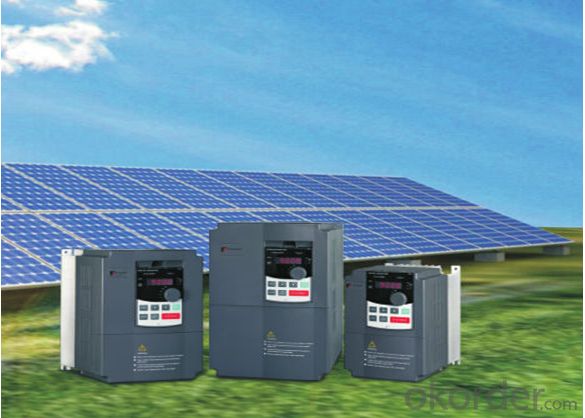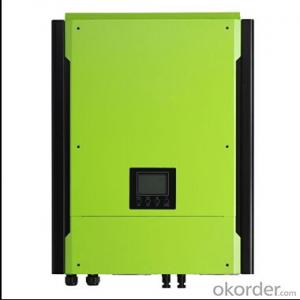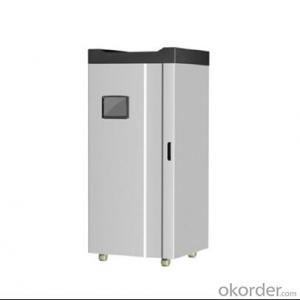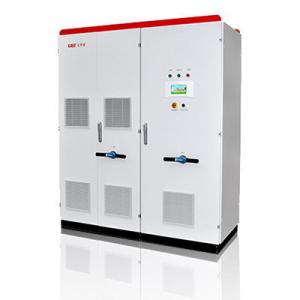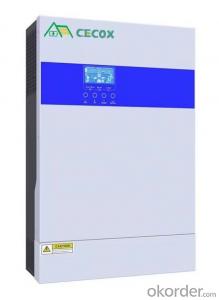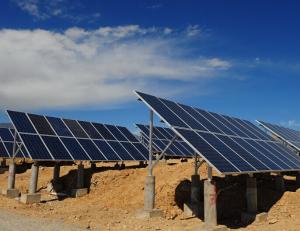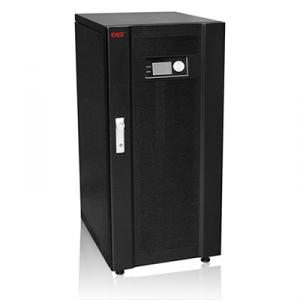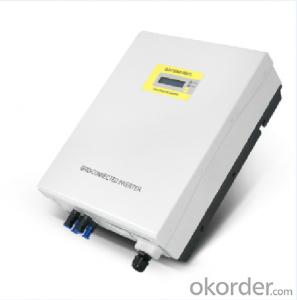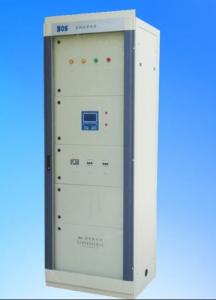Solar Inverter Adelaide - Off Grid MPPT Solar Inverter, Solar Pump Inverter 380V 2.2KW 4KW 5.5KW
- Loading Port:
- Shanghai
- Payment Terms:
- TT or LC
- Min Order Qty:
- 150000 watt
- Supply Capability:
- 3000000 watt/month
OKorder Service Pledge
OKorder Financial Service
You Might Also Like
1. Structure of Off Grid MPPT Solar Inverter, Solar Pump Inverter 380v 2.2kw 4kw 5.5kw Description
A solar inverter, or PV inverter, or Solar converter, converts the variable direct current (DC) output of a photovoltaic (PV) solar panel into a
utility frequency alternating current (AC) that can be fed into a commercial electrical grid or used by a local, off-grid electrical network. It is
a critical BOS–component in a photovoltaic system, allowing the use of ordinary AC-powered equipment. Solar inverters have special
functions adapted for use with photovoltaic arrays, including maximum power point tracking and anti-islanding protection.
2. Main Features of the Off Grid MPPT Solar Inverter, Solar Pump Inverter 380v 2.2kw 4kw 5.5kw
﹒ Supports AC&DC input:
DC solar panel input. And If no good sunshine, can use grid AC regular input work the pumps.
﹒Dry protection :
If no water in the ground, the water pump will stop working automaticly and when the water comes, starts to working automaticly.
﹒Automatic working:
When the sunshine not good then pumps slow down automatically and when sun become good then go on working.
﹒Save cost/directly connect solar panel:
Solar panle connects solar inverter directly and to the pump. Also can control the water level in the tank. No enough water in the tank
working fast, enough water will stop working automaticly. (how many water you need, you can set the parameters)
﹒Speed & frequency control, No need battery:
3. Off Grid MPPT Solar Inverter, Solar Pump Inverter 380v 2.2kw 4kw 5.5kw Images
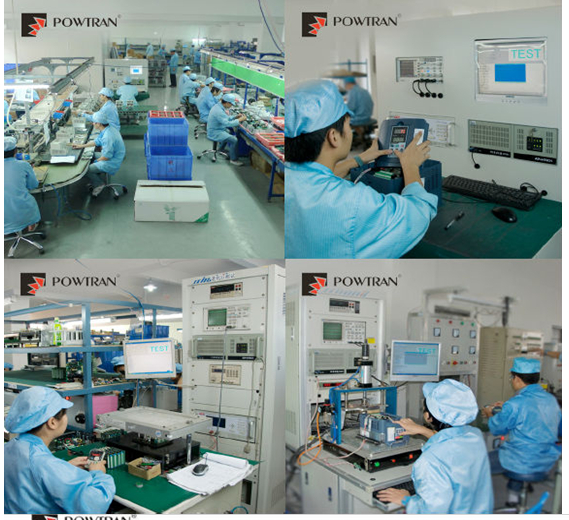
4. Off Grid MPPT Solar Inverter, Solar Pump Inverter 380v 2.2kw 4kw 5.5kw Specification
Inverter Model | Input voltage | Rated output power (kW) | Rated output current (A) |
PI9100-S 0R4G1 | Single phase AC 220V ± 10%;
DC 220-380V | 0.4 | 2.5 |
PI9100-S 0R7G1 | 0.75 | 4 | |
PI9100-S 1R5G1 | 1.5 | 7 | |
PI9100-S 2R2G1 | 2.2 | 10 | |
PI9100-S 004G1 | 4.0 | 16 | |
PI9200-S 5R5G1 | 5.5 | 25 | |
PI9100-S 0R4G2 | 3 phase AC 220V ± 10%;
DC 220-380V | 0.4 | 2.5 |
PI9100-S 0R7G2 | 0.75 | 4 | |
PI9100-S 1R5G2 | 1.5 | 7 | |
PI9100-S 2R2G2 | 2.2 | 10 | |
PI9100-S 004G2 | 4.0 | 16 | |
PI9200-S 5R5G2 | 5.5 | 25 | |
PI9200-S 7R5G2 | 7.5 | 32 | |
PI9200-S 011G2 | 11 | 45 | |
PI9200-S 015G2 | 15.0 | 60 | |
PI9100-S 0R7G3 | 3 phase AC 380V ± 10%;
DC 350-750V | 0.75 | 2.5 |
PI9100-S 1R5G3 | 1.5 | 3.8 | |
PI9100-S 2R2G3 | 2.2 | 5.1 | |
PI9100-S 004G3 | 4.0 | 9 | |
PI9100-S 5R5G3 | 5.5 | 13 | |
PI9100-S 7R5G3 | 7.5 | 17 | |
PI9230-S 011G3 | 11 | 25 | |
PI9230-S 015G3 | 15 | 32 |
5. FAQ of Off Grid MPPT Solar Inverter, Solar Pump Inverter 380v 2.2kw 4kw 5.5kw
Q1. What is the difference between inverter and solar inverter?
A1. Inverter only has AC inpput, but solar inverter both connect to AC input and solar panel, it saves more power.
Q2. What is the difference between MPPT&PWM?
A2. MPPT has higher efficiency, it can track the max power point and won't waste energy.
Q3. What is the waranty of product?
A3. 12 months.
- Q: How does a solar inverter handle voltage regulation during load changes?
- A solar inverter handles voltage regulation during load changes by continuously monitoring the load and adjusting the inverter's output voltage accordingly. It uses various control mechanisms to maintain a stable voltage output, such as pulse width modulation (PWM) and maximum power point tracking (MPPT) algorithms. These algorithms enable the inverter to regulate its output voltage to match the load requirements, ensuring a consistent and reliable power supply.
- Q: Can a solar inverter be used without solar panels?
- No, a solar inverter cannot be used without solar panels. The purpose of a solar inverter is to convert the direct current (DC) generated by solar panels into alternating current (AC) that can be used to power electrical devices in a home or building. Without solar panels producing DC electricity, there would be no input for the inverter to convert.
- Q: Can a solar inverter be used with a generator as a backup power source?
- Yes, a solar inverter can be used with a generator as a backup power source. The solar inverter can be connected to the generator's output, allowing it to convert the generator's AC power into usable DC power for charging the batteries or powering the solar energy system. This setup ensures uninterrupted power supply during periods of low solar generation or in case of power outages.
- Q: Does a solar inverter require any additional cooling or ventilation?
- Yes, a solar inverter typically requires additional cooling or ventilation to operate efficiently and prevent overheating. The heat generated during the conversion of DC to AC power needs to be dissipated to maintain optimal performance and prolong the lifespan of the inverter.
- Q: Is it possible to upgrade my existing solar inverter without replacing the entire system?
- Yes, it is possible to upgrade an existing solar inverter without replacing the entire system. In many cases, inverters can be easily replaced or upgraded to newer models that offer improved functionalities or higher performance. However, it is important to consult with a professional solar installer to ensure compatibility and feasibility before making any changes to the existing system.
- Q: Can a solar inverter be used with a solar-powered outdoor lighting system?
- Yes, a solar inverter can be used with a solar-powered outdoor lighting system. The solar inverter converts the direct current (DC) generated by the solar panels into alternating current (AC) that can power the outdoor lighting system.
- Q: Are solar inverters compatible with battery storage systems?
- Yes, solar inverters are compatible with battery storage systems. In fact, solar inverters play a crucial role in integrating battery storage with solar power systems. Solar inverters convert the direct current (DC) electricity generated by the solar panels into alternating current (AC) electricity that can be used to power our homes and businesses. Battery storage systems, on the other hand, store excess solar energy for later use, allowing us to use solar power even when the sun is not shining. When combined with solar inverters, battery storage systems can be charged using the excess energy generated by the solar panels during the day, and then discharge that stored energy during the night or during periods of high energy demand. To facilitate compatibility, solar inverters used in battery storage systems are equipped with additional features and functionalities. For example, they may have built-in charge controllers that regulate the charging and discharging of the batteries, ensuring their optimal performance and longevity. Additionally, advanced inverters may also include smart grid capabilities, allowing them to communicate with the utility grid and optimize energy flows based on grid conditions and electricity prices. Overall, solar inverters are essential components in ensuring the seamless integration of battery storage systems with solar power, enabling us to maximize the benefits of clean and sustainable energy.
- Q: How does a solar inverter handle voltage transients?
- A solar inverter handles voltage transients by regulating and stabilizing the incoming DC voltage from the solar panels, and converting it into a steady AC voltage suitable for use in the electrical grid or for powering appliances. It uses various electronic components and control algorithms to monitor and adjust the voltage levels, ensuring that any sudden changes or fluctuations in the input voltage are smoothed out and the output remains consistent and within acceptable limits.
- Q: How does the input power rating affect the performance of a solar inverter?
- The input power rating directly affects the performance of a solar inverter. A higher input power rating allows the inverter to handle larger amounts of power generated by the solar panels. This means that a higher input power rating can lead to better efficiency and performance of the solar inverter, as it can convert a greater amount of solar energy into usable electricity. Conversely, a lower input power rating may limit the inverter's capacity to handle high power outputs, potentially resulting in reduced efficiency and performance.
- Q: How does a solar inverter affect the overall energy consumption of a property?
- A solar inverter converts the direct current (DC) generated by solar panels into alternating current (AC) that can be used to power electrical appliances in a property. By efficiently converting DC to AC, a solar inverter enables the property to utilize the renewable energy generated by the solar panels. This reduces the reliance on grid electricity, thereby decreasing the overall energy consumption of the property and leading to potential cost savings on electricity bills.
Send your message to us
Solar Inverter Adelaide - Off Grid MPPT Solar Inverter, Solar Pump Inverter 380V 2.2KW 4KW 5.5KW
- Loading Port:
- Shanghai
- Payment Terms:
- TT or LC
- Min Order Qty:
- 150000 watt
- Supply Capability:
- 3000000 watt/month
OKorder Service Pledge
OKorder Financial Service
Similar products
Hot products
Hot Searches
Related keywords
